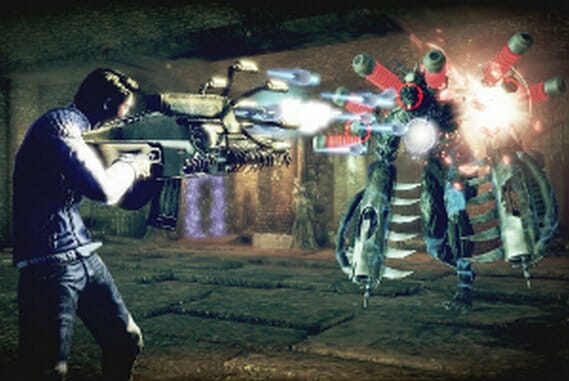Shadows of the Damned
(Multi-platform)

When it was first conceptualized in 2006, Shadows of the Damned was a horror game based around a simple idea: the physical and psychological negotiation of light and darkness. At the time, Grasshopper Manufacture head Goichi “Suda51” Suda explained the project was being modeled after the works of Kafka, with the game’s protagonist using a torch to explore a surreal castle and its surrounding village area, interacting with the strange citizens that lived there. Though it was only a year after Killer 7 had brought Grasshopper to North American shores for the first time, the proof-of-concept (such as it was) for the project—then called Kurayami after the Japanese word for darkness—exemplified that Suda had arguably always had the chops, if not quite the exposure and resources, needed to fully and effectively bring his decidedly unique brand of auteurism to the medium of video games.
In 2011, the fully-finished Shadows of the Damned is a far cry from what Kurayami was originally conceived as. Instead of an interactive adaptation of Kafka’s The Castle, which Suda’s initial idea seemed to closely resemble, Shadows is a puerile and comic exercise in camp horror. Following demon hunter Garcia Hotspur through Hell to rescue his girlfriend Paula, the game is chock-full of Suda’s signature character and attitude—Garcia’s companion is a horny ex-demon named Johnson (who affects a British accent and can transform into various hellspawn-killing upgradable ordnance); Demons repeatedly burst out of Paula’s body as though outgrowing her skin like a too-small suit; corridors and facades in vaguely-Mexican shantytowns are adorned with mounted goat heads and randomly festooned with entrails.
Shadows also has a lot of dick jokes—enough to easily match the perpetual barrage of pop-cultural pastiche, self-aware-if-lowbrow humor, blatant sexual innuendos and over-the-top violence that have become Suda’s trademarks. The sheer amount of phallic references here may well in fact fuel numerous articles posturing behind-the-curtain Freudian power politics in the coming months. There’s no doubt that this is a Grasshopper game, and yet as far as its kitsch style may have fallen from what seemed to be Kurayami’s more cerebral intentions, Shadows still shows that Suda has come into his own; his directorial sensibilities have often struck me as resembling an offbeat pairing of Robert Rodriguez and Seijun Suzuki with a hefty dose of surrealism, and I’ve always maintained that he is a designer that imbues his creations with pointed purpose, even when he obtusely appears to be designing at his most arbitrary. Similarly, Grasshopper has proven time and again that it lives and dies by its sometime motto “Punk’s Not Dead,” presenting their titles as off-kilter and a little rough around the edges, even at times to the point of player alienation—though that’s part of their inherent (and imminently bizarre) charm.

I had a hard time adjusting to Shadows’ comparatively smooth, polished design texture for these reasons at first; it was as though, like poor Paula, someone else was piloting Suda’s hollow body around like a marionette, a familiar exterior belying the presence of someone else’s guts underneath.
Part of this makes sense, given that Suda partnered with Resident Evil creator Shinji Mikami to make sure that combat mechanics were as solid and polished as they were in RE4. What remains of Kurayami’s darkness element also plays an active role in gameplay, as the environment is often overrun with combative shadow that eats away at mortals, draining Garcia’s health. (In such cases you have to find a way to extinguish the dark by using Johnson’s special light shot in various light vs. dark puzzles.) It took some time adjusting before I came to accept Shadows as the game with the most mainstream feel, more or less, that Grasshopper has ever released in the U.S, insofar as “feel” constitutes precise mechanics and generally straightforward design elements. Stylistically it’s still easy to classify a title with belching demon baby heads and lewd storybook sessions awkwardly read aloud by the protagonist and his sidekick as undoubtedly characteristic of Suda; it’s everything else that feels more practical and, well, “normal.” Even so, Shadows is begging you not to take it seriously, even when Johnson, uh, jerks himself off to become a long range weapon (the Big Boner) and lines like “Demons are buttholes!” and “Your bullets have no bite. No…penetration,” are delivered with the utmost sincerity from their voice actors.